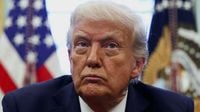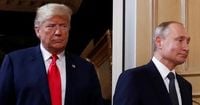The ongoing conflict between Russia and Ukraine has entered a new phase, as the United States has recently proposed a framework for a peace agreement aimed at ending hostilities. According to Bloomberg, the U.S. has presented its allies with proposals that outline conditions for a ceasefire and the easing of sanctions against Moscow, contingent on a lasting truce.
This American plan, however, has raised eyebrows, as it appears to effectively freeze the conflict while leaving occupied territories under Russian control, without necessitating acknowledgment of Russia's territorial gains. Notably, the proposal excludes Ukraine's potential NATO membership, a contentious point that has been a significant aspect of the ongoing war.
On April 18, 2025, U.S. Secretary of State Marco Rubio shared details of the framework agreement with European allies and informed Russian Foreign Minister Sergei Lavrov about the discussions. "We think it was positive that no one got up from the table and walked away," Rubio stated, highlighting the importance of continued dialogue. However, he also warned that if the plan proves unfeasible in the coming days, the U.S. will shift its focus to other matters, potentially sidelining the conflict in Ukraine.
In Paris, discussions included a Franco-British proposal to establish 'insurance' forces in Ukraine to bolster its military capacity. Rubio emphasized the necessity for Ukraine to feel confident in its ability to defend itself against future attacks, stating that Ukraine would have the right to enter into any bilateral agreements regarding its defense.
While the U.S. is considering easing sanctions on Russia, this proposal has been criticized by some European nations who fear it could legitimize Russia's occupation of Ukrainian territories. The European Union requires unanimity for lifting sanctions, and the prospect of easing restrictions while Russia maintains control over annexed regions complicates matters significantly.
As the conflict continues, it is essential to remember that the war began 1150 days ago when Russia launched its armed invasion of Ukraine. The U.S. administration, under President Donald Trump, has indicated a willingness to recognize Russia's control over Crimea as part of a broader peace deal. This stance has sparked concern, as it could undermine international agreements that prohibit the forcible acquisition of territory.
In a recent interview, Steve Witkoff, a U.S. envoy, remarked that Putin seems fixated on Ukrainian land, suggesting that Russia may be willing to accept some regions, but not all. Witkoff's comments have been met with strong rebuttals from Ukrainian President Volodymyr Zelensky, who firmly denies any readiness to recognize the annexation of Ukrainian territories.
In a significant move, Zelensky announced that Ukraine has imposed sanctions on Chinese companies involved in the production of Russian Iskander missiles, indicating a broader strategy to counteract Russian military capabilities.
The war has also seen humanitarian efforts, with Ukraine receiving substantial aid from various countries. Recently, 11 shipments of humanitarian assistance arrived from Lithuania, Poland, and Belgium, aimed at supporting the energy sector amid ongoing attacks. Since March 2022, Ukraine has received over 245 shipments of aid from Lithuania alone.
On the battlefield, the situation remains dire. Ukrainian forces shot down 33 out of 87 Russian drones in a recent engagement, while Russian attacks continue to inflict casualties and damage. Tragically, a 16-year-old boy succumbed to injuries sustained during a Russian assault in Kherson, highlighting the human cost of the conflict.
Looking ahead, military exercises are set to take place in Estonia from May 5 to May 23, involving NATO forces, including units from the UK and France. This demonstrates a continued commitment among NATO allies to bolster defense capabilities in response to Russian aggression.
As the U.S. navigates its role in these negotiations, there are growing concerns regarding the lack of concrete discussions about new military aid packages for Ukraine. With existing support nearing its end, U.S. officials have reportedly not engaged in serious talks about further assistance, raising alarms among proponents of Ukrainian sovereignty.
In conclusion, the proposed peace framework by the United States reflects a complex landscape of diplomacy, military strategy, and humanitarian concerns. The coming days will be crucial in determining whether these negotiations yield a viable path toward peace or if the conflict will continue unabated.

![Bloomberg: USA gotowe oddać Rosji Krym [NA ŻYWO]](https://thumbor.evrimagaci.org/-Gc89LNPLJMhCUQolRS9n8ej7MU=/200x0/tpg%2Fsources%2Fcbe6be5b-617a-4882-a8ba-55404d7810fc.jpeg)






